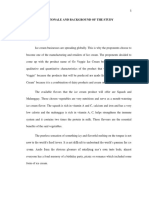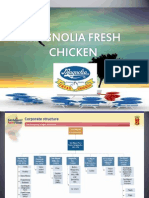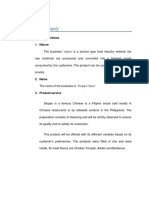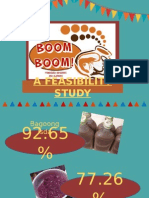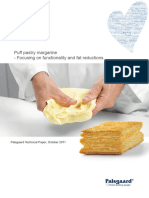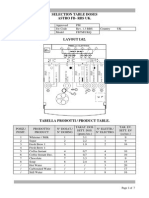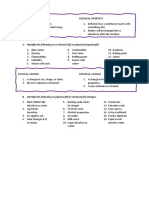Market Potential of Banana Chips Industry in Malaysia
Uploaded by
MARDI ScribdCopyright:
Available Formats
Market Potential of Banana Chips Industry in Malaysia
Uploaded by
MARDI ScribdOriginal Title
Copyright
Available Formats
Share this document
Did you find this document useful?
Is this content inappropriate?
Copyright:
Available Formats
Market Potential of Banana Chips Industry in Malaysia
Uploaded by
MARDI ScribdCopyright:
Available Formats
Hamir 2006:
and Mohd.
Khairol Mohd. Ariff
Economic and Technology Management Review. Vol. 1Noor
No.Auni
1 (June)
8390
Market potential of banana chips industry in Malaysia
(Potensi pemasaran industri kerepek pisang di Malaysia)
Noor Auni Hamir* and Mohd. Khairol Mohd. Ariff**
Key words: banana chips, potential, marketing, snack
Abstract
A primary survey was conducted in 2003, involving entrepreneurs in processing
banana chips. Results of the survey showed that 59% of respondents indicated that
the demand for domestic market is good and 17% of them rated as very good.
Thirty-six per cent of the respondents that are involved in exporting banana chips
indicated that the demand for export market as good and 27% of them indicated as
very good. Forty-two per cent of respondents indicated that they faced problems in
peeling off the banana skins and 13% of them indicated that as a major problem.
Seventy per cent of respondents indicated that their market for banana chips are
presently increasing and 77% forecasted that their market would expand in the
future. Therefore, as a strategy to boost the development of the banana chip industry,
the promotion of the consumption of banana chips as a healthy food is needed. As
the industry expands, there is also a need to develop a banana peeling machine to
overcome the labour shortage.
Introduction
The snack food industry includes the
manufacture of potato chips, corn chips,
popcorns, pretzels, extruded snacks, seeds and
nuts (peanuts) and chocolates. The locally
produced savoury snacks are chips and
keropok. In general, the demand for snack
food in the world, including Malaysia, is
expected to increase in the future, as there is
an increasing number of working women who
spent less time cooking. The number of
working women in Malaysia has increased
from 2.6 million in 1992 to 3.7 million in
2004, an increase of 42% within this period
(Anon. 2005). This survey was undertaken to
study the current status of the banana chip
industry, to identify the problems and
constraints that the industry is facing, and to
suggest strategies in promoting the growth of
the banana chip industry.
Methodology
The survey on banana chips entrepreneurs
was conducted in 2003. The methodology
involved the collection of primary as well as
secondary data. The primary data were
collected via a survey of the banana chips
producers, while the secondary data, were
collected from the Department of Statistics,
Department of Agriculture and also through
the Internet. The information on the number
of chips producers, together with their
addresses were gathered from the Department
of Agriculture. All the accessible banana chips
producers in all the states in Peninsular
Malaysia were surveyed.
Industrial overview
The common banana chips produced in the
world are the banana figs, savoury banana
chips and sweet banana chips. The most
*Economic and Technology Management Research Centre, MARDI Headquarters, Serdang, Selangor, Peti Surat 12301,
50774 Kuala Lumpur
**Business Development Unit, MARDI Headquarters, Serdang, Selangor, Peti Surat 12301, 50774 Kuala Lumpur
E-mail: auni@mardi.my; khairol@mardi.my
83
Market potential of banana chips industry in Malaysia
common banana chip produced in Malaysia is
savoury banana chip. The global volume sale
of chips/crisps grew at 3.6%, from 1,825,000
tonnes in 2000 to 1,890,600 tonnes in 2001.
In terms of value, it increased by 2.3%, from
US$13,943.1 million in 2000 to US$14, 268.5
million in 2001. The retail sale of savoury
snacks in Malaysia increased from 16, 659.5
tonnes in 1998 to 19, 302.2 tonnes in 2002, an
increase of 16% within that period. In terms
of value, it increased from RM360.6 million
in 1998 to RM426.8 million in 2002, an
increase of 18% within that period (Anon.
2003).
Snack consumption
The snack food consumption is on the
increasing trend. According to the American
Snack Food Association survey done in 1996,
potato chip was the most popular snack food
exported to Canada, Western Europe, the Asia
Pacific Rim and the Middle East. This was
followed by tortilla chips, other corn-based
products, pretzels, extruded snacks, and readyto-eat popcorns (Anon. n. d.). The number of
consumers who snacked between meals at least
once a day was highest in the United States
(80%), followed by Germany (74%), United
Kingdom (69%), Japan (66%), Brazil (64%),
Italy (62%), Spain (57%), and France (53%)
(Anon. 1997).
In 1996, Japan had the highest per capita
consumption in terms of value at US$70.6,
but in terms of quantity, the United States had
the highest per capita consumption at 8.6 kg.
However, in the year 1997, in terms of value,
the United Kingdom overtook Japan as the
main consumer of savoury snacks. In the year
2000, the consumption of savoury snacks in
Japan did not show a very encouraging trend
because Japan was still suffering from the
recession then. The consumers were still very
cautious with their expenditures and there was
also increased competition from fast foods.
The recession and the competition from fast
foods also affected the consumption of snack
foods in the other Asia Pacific region (Anon.
2003). According to the Australian Trade
Commission, nutritional snacks such as fruit
84
rolls and yogurt bars have the opportunity to
enter the Malaysian markets (Anon. 2002).
Detailed consumption of per capita snack food
is shown in Table 1.
Results of primary survey
Background of entrepreneurs
There were only 124 banana chips operators
in the country. Of this, 24% are located in
Kelantan, 16% each in Selangor, Johor and
Kedah, 11% in Negeri Sembilan, 7% in
Pahang, 6% in Perak and 4% in Melaka.
Ninety-four per cent of them are owner
operators, 4% are partnership and 2% are
limited companies. The average business
operating period was 9 years, ranging from 1
to 25 years. Twenty-eight per cent of them are
involved in planting their own bananas to
supply their banana chips factories. The
average self-supplied operators was 47%,
ranging from 2% to 100%. For those involved
in the purchasing of raw bananas, the average
percentage of purchase for their factory
utilisation was 93%, ranging from 20 100%.
Production
The average production of banana chips per
day by each entrepreneur surveyed was 54 kg.
The average production day per month was
17 days while the total average monthly
production was 918 kg. This resulted in the
total monthly production of banana chips in
Malaysia to almost 113.8 tonnes per month or
1,365.6 tonnes per year. At an average
wholesale price of RM6.8 per kilogramme,
the production value of banana chips in
Malaysia was estimated to be RM9.3 million
per year. Results of the analysis also showed
that the average production capacity was 269
kg while the average production was 159 kg.
That means 41% of the total production
capacities were underutilised each day and
that only 70% of the production days were
utilised per month.
Marketing
All the banana chips entrepreneurs are involved
in selling their products to the domestic
markets. Ninety-seven per cent of the products
Noor Auni Hamir and Mohd. Khairol Mohd. Ariff
Table 1. Global consumption of savoury snacks by major markets: Per capita analysis 19962000
Country
Japan
UK
US
Australia
Greece
Netherlands
Canada
Taiwan
South Korea
Mexico
Spain
Germany
South Africa
France
Colombia
Italy
Brazil
Philippines
Indonesia
Russia
China
World average
Yearly per capita consumption
1996
1997
1998
1999
2000
70.6 (5.7)*
65.9 (5.4)
54.9 (8.6)
44.5 (3.8)
42.5 (n. a.)
36.1 (5.3)
26.9 (2.8)
26.9 (n. a.)
19.4 (2.0)
16.1 (3.6)
14.2 (1.8)
13.8 (2.1)
13.7 (1.8)
13.5 (1.9)
10.9 (2.1)
8.6 (1.0)
6.3 (0.6)
5.7 (n. a.)
4.2 (2.5)
1.6 (n. a.)
0.6 (0.1)
7.9 (1.1)
62.4 (5.6)
71.8 (5.6)
57.5 (8.9)
43.7 (3.9)
41.8 (n. a.)
31.4 (5.4)
27.1 (2.9)
24.1 (n. a.)
17.5 (2.0)
24.1 (3.8)
12.6 (1.8)
12.0 (2.1)
11.8 (1.8)
12.6 (1.8)
12.6 (1.8)
7.8 (1.0)
8.4 (1.0)
5.5 (n. a.)
3.8 (2.3)
3.1 (n. a.)
0.6 (0.1)
7.9 (1.1)
56.8 (5.5)
75.2 (5.8)
59.9 (9.2)
39.4 (4.0)
43.0 (n. a.)
33.0 (5.6)
25.8 (2.9)
22.0 (n. a.)
11.8 (1.9)
20.1 (3.9)
13.3 (2.0)
11.7 (2.1)
11.6 (1.8)
12.0 (1.8)
13.1 (2.4)
7.8 (1.0)
8.9 (0.8)
4.3 (n. a.)
1.4 (2.2)
3.3 (n. a.)
0.6 (0.1)
7.7 (1.1)
65.1 (5.5)
74.2 (6.0)
62.6 (9.3)
44.0 (4.2)
45.4 (n. a.)
33.2 (5.7)
26.4 (3.0)
22.7 (n. a.)
14.6 (2.0)
22.7 (4.1)
14.6 (2.3)
11.3 (2.1)
10.8 (1.8)
11.8 (1.9)
13.1 (2.4)
9.1 (1.2)
6.9 (0.8)
4.9 (n. a.)
1.8 (2.3)
2.8 (n. a.)
0.6 (0.1)
8.0 (1.1)
68.2 (5.5)
70.0 (6.0)
67.0 (9.7)
41.0 (4.4)
41.6 (n. a.)
28.4 (5.8)
27.2 (3.0)
23.3 (n. a.)
15.6 (2.0)
24.2 (4.3)
13.1 (2.5)
9.2 (2.1)
9.6 (1.8)
10.0 (1.9)
12.7 (2.5)
8.6 (1.4)
6.4 (0.7)
4.8 (n. a.)
1.8 (2.3)
3.5 (n. a.)
0.6 (0.1)
8.1 (1.2)
*70.6 (5.7), where 70.6 = US$70.60, and (5.7) = 5.7 kg/capita
Source: Anon. (2003)
produced are for the domestic market while
only 3% are for the export markets. Generally,
both the domestic and export markets are
considered as good. Seventeen per cent of the
respondents considered their domestic markets
as very good, 59% as good, 20% as unsure,
2% as not satisfactory and 2% as not good.
Only eight entrepreneurs are involved in
exporting their products. They are mainly
exported to Singapore. Twenty-seven percent
of them cited their export market as very good.
The details of the market situation are shown
in Table 2.
Market performance
Results of the study indicated that the banana
chip industry is a growing industry. The
consumption of banana chips is expected to
increase because there is a growing consumer
concern towards ethnic food and healthy food.
The lower fat and non-fat chips are becoming
popular. Presently, consumers are looking for
Table 2. Market situations of the banana chips
industry
Ranking
Very good
Good
Unsure
Not satisfactory
Not good
Marketing (% response)
Domestic
Export
17
59
20
2
2
27
37
9
27
products with low fat and non-fat, rich in
vitamins or made from organic ingredients
with less or without preservatives (Anon.
2003). Based on the survey of producers on
their last 5 years experience, 70% of them
indicated that their sales showed an increasing
trend at an average rate of 33%, ranging from
3100%. Based on their business experiences,
77% of them forecasted that their sales would
grow by 36% for the next 5 years. Further
details on the market performance are shown
in Table 3.
85
Market potential of banana chips industry in Malaysia
Prices
Results of the study revealed that 50% of the
products were sold to wholesalers (who mostly
collect the products from the factories) and
the other 50% were for retailing. The average
wholesale and retail prices of banana chips
were RM6.80/kg and RM7.70/kg respectively.
These bananas chips also included varieties
made from Tanduk and Nipah. The
wholesale prices for banana chips made
from Tanduk and Nipah varieties were
RM9.00/kg and RM5.00/kg respectively. At
wholesale price, the salty cassava chips was
the cheapest, followed by hot/chilly cassava
chips, banana chips and others as shown in
Table 4. The smallest marketing margin
between wholesale and retail prices was for
the hot/chilly cassava chips (dry), that is only
3%, while the others are as shown in Table 4.
analysis because they used deep fryers, which
are very expensive (average RM23,000) as
compared to frying pans (average RM700).
The results of the analysis on the 'Tanduk'
banana chips showed that the Net Present
Value was RM5,002, benefit cost ratio at
1.08, Internal Rate of Return (IRR) >50%,
and the payback period was 1 year. The 'Nipah'
variety had a Net Present Value of RM9,925,
IRR>50%, benefit cost ratio 1.37 and the
payback period was 1 year. The Nipah chips
gave higher returns because of the cheaper
raw materials which was easily available at a
cost of only RM0.40/kg. While the lower
returns from the Tanduk banana chips were
due to costly raw materials which was sold at
RM1.70/kg and the low yield from the crop.
The overall results showed that the banana
chips industry is a viable project.
Financial analysis
Financial analysis was conducted to analyse
the viability of the banana chips production
projects. The project analysis was based on
the average industrial data, whereby 9
respondents (7%), were excluded in the
Production problems
The survey results showed that the industry,
generally, does not face very serious
production problems. However, among the
problems they encountered were the machines
used such as deep fryers, vacuums, and mixers
Table 3. Market performance (values) of the banana chips industry
Growth performance (%)
Increase
Decrease
Static
Industrial growth performance
for the last five years
70
12
18
Expected industrial future
performance based on the
last five years of experience
77
19
Table 4. The average selling price of traditional chips in Malaysia
Types of chips
Banana chips
Salty cassava chips
Hot/chilly cassava chips (wet)
Hot/chilly cassava chips (dry)
Sweet potato chips
Custard apple chips
Yam chips
Prices of traditional chips (RM/kg)
Wholesale
Retail
Marketing margin*
6.80
5.70
6.40
7.20
7.00
7.80
7.40
7.70
6.50
7.10
7.40
7.70
9.15
8.30
13
14
11
3
10
17
12
*% differences between wholesale and retail prices
86
Noor Auni Hamir and Mohd. Khairol Mohd. Ariff
which are relatively expensive, lack of raw
materials (bananas), and unavailability of
peeling machines. Generally, farmers refuse
to sell unripe bananas because the price is too
low. For example, the price of unripe Pisang
Tanduk is RM1.70/kg and 'Pisang Nipah' is
RM0.40/kg. Details on the production
problems faced by the entreprenuers are shown
in Table 5.
Marketing problems
The producers did not encounter many
marketing problems. They sell almost
everything that they produce. They have their
own markets. To them, the banana chip is not
competing with the potato or tapioca chips.
Their products are not easily spoilt and the
product acceptance is good. This can be seen
clearly in Table 6.
Marketing strategies
A TOWS MATRIX analysis (Table 7) is used
to analyse the strength, weakness, opportunity
and threat of the industry, in order to suggest
the strategic direction for the development of
the banana chips industry in Malaysia. From
the TOWS MATRIX analysis, it was found
that the marketing process of the Malaysian
banana chips producers were very weak. They
depend so much on the wholesalers to market
their products. These wholesalers were not
aggressively marketing their products. These
wholesalers distributed their products to the
retailers who are normally selling grocery
products and tit bits in stalls located near bus
stands, cinemas, and in petrol station shops.
There is, therefore a need to strengthen the
present marketing linkages in order to sustain
the present markets and also to further increase
the market share. The marketing strategies
need to be further strengthened by establishing
brands so that the banana chips can enter into
the supermarkets.
So far, there is no advertisement to
promote the consumption of banana chips in
Malaysia. There is no public awareness
towards the benefit of consuming banana chips
as compared to other chips, which mostly
contain mono sodium-glutamate. Besides
containing sugar, carbohydrate, protein and
Table 5. Production problems faced by the entreprenuers
Problems (% response)
Problems
Banana chips machines are too expensive
Expensive wage rate
High rate of labour turnover
Inaccurate bananas harvesting index
Unavailability of peeling machine
Lack of machine utilization
Lack of raw materials (banana)
Lack of labour
Unsuitable machines
Raw materials are too expensive
Main
Intermediate
Small
No
14
2
1
2
13
8
12
2
9
6
33
4
5
8
42
25
26
5
22
22
20
21
16
21
11
26
25
21
23
27
33
74
78
69
34
41
37
72
46
45
Table 6. Marketing problems in the banana chips industry
Problems
Competing with potato chips
Competing with tapioca chips
Easily spoilt product
Not a good sale
Product acceptance not so good
Problems (% response)
Yes
No
17
27
24
19
6
83
73
76
81
94
87
Market potential of banana chips industry in Malaysia
Table 7. TOWS MATRIX analysis of banana chips industry
Strengths-S
1. A financially viable project
2. Good demand domestically
and for export
3. Good government support
4. Effective production
and packaging techology
5. Good quality products
6. Long shelf-life
7. Good road and air
transportation systems
8. Well accepted by domestic
and Singapore markets.
Weaknesses-W
1. Not attractive packaging
2. Lack of flavour variations
3. No promotion to increase
consumption
4. Weak marketing agents
5. Weak marketing linkages
6. Lack of the Tanduk
variety bananas
7. Absence of peeling machine
and cheap slicer machines
8. Absence of brands
Opportunities-O
1. Growing future demand,
especially in the domestic
and Singapore markets
2. Available technology
generators to further
modify the chips flavours
3. Producers have established
good rapport with the
wholesalers
4. As import substitution
SO Strategies
1. To be more competitive,
there is a need to further
improve the production
technology and capability
WO Strategies
1. Provide many flavour
variations of banana
chips
2. Invent banana peeling
machines and cheap slicer
machines
3. Strengthen marketing
linkages
4. Encourage more production
of the Tanduk variety
5. Improve packaging including
expiry dates
Threat-T
1. Aggressive modification
of other snack foods,
e.g. Dorito
2. Established companies
(snack food) have strong
marketing linkages,
example Sparta Foods,
Inc. in the US with
Rupari Food Services, Inc.
3. Less fat or no fat
modification of other
savoury snacks
ST Strategies
1. Produce less fat and
salt banana chip
WT Strategies
1. Intensify promotional
activities
2. Strengthen marketing
strategies
3. Establish brands
fat, banana also contains vitamins such as
vitamin A, B1, Niacin, B2, B6 and also vitamin
C (Anon. 2000). Perhaps, the government
agencies should help in making the public
aware towards the consumption of the banana
chips through campaigning in the mass media.
Normally, banana chips are packed in
transparent plastics without labels and are not
as attractive as those chips and other tit bits
produced by giant companies. As a strategy to
increase sale, there is thus, a need to improve
88
the packaging so that they will look more
attractive and impressive to the potential
buyers and giving the products an impression
of higher quality. Packaging size and design
should suit the target market, whether it is for
adults or children. Usually, large size
packaging is for the adult market which is
sufficient for the family. The small eyecatching packaging should target children or
individual consumption. Expiry dates should
be specified on the packagings.
Noor Auni Hamir and Mohd. Khairol Mohd. Ariff
There are many R&D institutions
throughout the country. As a strategy to
promote the growth of this industry, the
technology generators need to be more
innovative in creating more flavours for
banana chips. The flavours should be more
spicy and sweet as generally, Malaysians tend
to have sweet tooth and enjoy spicy foods.
A banana peeling machine need to be
invented as currently most producers peel the
banana skins manually. As most producers
are operating on a small scale, cheap banana
slicer machines need to be invented. The
inventions of these machines will increase the
productivity of the banana chip industry.
Utilisation of an efficient production technique,
together with variations in flavours of banana
chips will help boost the growth of the banana
chip industry.
To further enhance the growth of the
banana chip industry, the production strategy
should be properly planned. There is a need to
identify the production areas for growing
bananas, either for fresh consumption or for
factory utilisation. The market linkages
between the farmers and the chips producers
should be established.
Specifically, R&D is required to further
increase the yield and productivity of the
Tanduk variety since the markets for 'Tanduk'
chips are very good. Presently, the Tanduk
variety in Malaysia is of lower yield as
compared to the other banana varieties in
Malaysia. Efforts in increasing productivity
of the 'Tanduk' variety will simultaneously
create more jobs opportunity for the rural
population, increase their incomes, and also
for survival of the industry in the future.
There is also a need to develop a costsaving technology for the production of
Tanduk banana chips for making the 'Tanduk'
industry more lucrative.
Conclusion
The demand for savoury snacks, including the
banana chips in Malaysia is increasing. The
value of the retail sale of savoury snacks in
Malaysia has increased by 18.4% from 1998
to 2002, which recorded an average growth
rate of 4.6%. The chips/crisps, excluding the
Tortilla and the corn chips recorded a 22.8%
growth from 1998 to 2002, with an annual
growth rate of 5.7% (Anon. 2003). Results of
this study indicated that the annual average
growth rate for banana chips was 6.6%. This
indicated that the growth rate of the banana
chips is higher than the average growth rate of
the general savoury snack.
The results of the survey on the producers
(based on their experiences), indicated that
the banana chip industry will continue to grow
in the future. The production and marketing
problems highlighted need to be tackled in
order for the industry to grow in future. To be
more competitive, there is a need to further
improve the production efficiency. There is a
need to improve packaging and promote
branding so that banana chips could be sold as
a high quality product.
References
Anon. (1997). Food Institute Report
http://www.facilitygroup.com
(2000). Teknologi Pisang. Department of
Agriculture, Kuala Lumpur: DOA
(2002). Australia trade: Processed food to
Malaysia). Australian Trade Commission.
http://www.austrade.gov.au./print_templat
(2003). Savoury snack.
http://www.euromonitor.com
(2005). Labour force survey report 2004
Malaysia. Department of Statistics Malaysia
(n.d.). Snacks and sweets statistics.
http://www.fiery-foods.com.
89
Market potential of banana chips industry in Malaysia
Abstrak
Bancian primer dijalankan pada tahun 2003 terhadap usahawan kerepek pisang.
Hasil kajian menunjukkan bahawa 59% daripada responden yang dibanci menyatakan
bahawa permintaan tempatan adalah baik dan 17% menyatakan amat baik. Tiga
puluh enam peratus responden yang terlibat dengan mengeksport kerepek pisang
menyatakan permintaan bagi pasaran eksport adalah baik dan 27% daripada mereka
menyatakan amat baik. Empat puluh dua peratus menyatakan mereka menghadapi
masalah membuang kulit dan 13% menyatakan masalah membuang kulit sebagai
masalah besar. Tujuh puluh peratus menyatakan bahawa pasaran mereka sedang
berkembang dan 77% menjangka pasaran mereka akan meningkat. Oleh itu, sebagai
strategi untuk membangunkan lagi industri kerepek pisang, promosi meningkatkan
pemakanan kerepek pisang patut dilakukan kerana kerepek pisang tergolong dalam
makanan kesihatan. Apabila industri berkembang, mesin pengupas kulit pisang
perlu diadakan untuk mengatasi masalah kekurangan buruh.
90
You might also like
- NASA Be Prepared Emergency Supply Kit PDFNo ratings yetNASA Be Prepared Emergency Supply Kit PDF12 pages
- Analysis OF Business Feasibility OF Banana Chips: Ruswaji, Puguh CahyonoNo ratings yetAnalysis OF Business Feasibility OF Banana Chips: Ruswaji, Puguh Cahyono4 pages
- Feasibility Study (Ang Taho Ni Pilimon Sa Plmun) : Pamantasan NG Lungsod NG MuntinlupaNo ratings yetFeasibility Study (Ang Taho Ni Pilimon Sa Plmun) : Pamantasan NG Lungsod NG Muntinlupa6 pages
- Fnaaaaaaaaaaaaaaaaaaaaaaaaaaalllllllllllll100% (1)Fnaaaaaaaaaaaaaaaaaaaaaaaaaaalllllllllllll22 pages
- Philippine Christian University: Senior High School Department Dasmariñas Campus100% (1)Philippine Christian University: Senior High School Department Dasmariñas Campus15 pages
- Feasibility Study Fruita de Empanada MM2 A PDFNo ratings yetFeasibility Study Fruita de Empanada MM2 A PDF104 pages
- Thesis On The Quality of Pastillas de Leche From Buffalo Milk:abstract60% (5)Thesis On The Quality of Pastillas de Leche From Buffalo Milk:abstract2 pages
- A Feasibility Study On The Establishment of Gerocaija Cucumber With Calamansi Juice in Catbalogan CityNo ratings yetA Feasibility Study On The Establishment of Gerocaija Cucumber With Calamansi Juice in Catbalogan City21 pages
- Acceptability and Marketability of Laing Siopao0% (1)Acceptability and Marketability of Laing Siopao6 pages
- This Study Resource Was: Background of The StudyNo ratings yetThis Study Resource Was: Background of The Study8 pages
- Sensory Acceptability of Lima Beans As TahoNo ratings yetSensory Acceptability of Lima Beans As Taho26 pages
- Scientia MARDI - Vol. 009 - Disember 2016No ratings yetScientia MARDI - Vol. 009 - Disember 201612 pages
- Scientia MARDI - Vol. 009 - Disember 2016No ratings yetScientia MARDI - Vol. 009 - Disember 201612 pages
- MARDI Transforming Agriculture To Boost Food Security (The BrandLaureate)100% (2)MARDI Transforming Agriculture To Boost Food Security (The BrandLaureate)5 pages
- Scientia MARDI - Vol. 008 - September 2016100% (2)Scientia MARDI - Vol. 008 - September 201612 pages
- Rags To Riches - Engaging Technologies To Eradicate Poverty100% (2)Rags To Riches - Engaging Technologies To Eradicate Poverty28 pages
- MARDI - Five Excellent Years of Innovation in Agriculture67% (3)MARDI - Five Excellent Years of Innovation in Agriculture129 pages
- Developing Malaysian Seed Industry - Prospects and Challenges100% (2)Developing Malaysian Seed Industry - Prospects and Challenges9 pages
- Scientia MARDI - Vol. 006 - September 2015100% (2)Scientia MARDI - Vol. 006 - September 201512 pages
- MARDI in Kehakaset Thai Home Agricultural Magazine100% (1)MARDI in Kehakaset Thai Home Agricultural Magazine18 pages
- "Hungry India"-Food and Chef Ordering System at Your Door-Step Using Android Based ApplicationNo ratings yet"Hungry India"-Food and Chef Ordering System at Your Door-Step Using Android Based Application4 pages
- UPDATED Agric Exam Marking Guide Second TermNo ratings yetUPDATED Agric Exam Marking Guide Second Term4 pages
- Full Download (Original PDF) Nutrition An Applied Approach 5th by Janice J. Thompson PDF100% (8)Full Download (Original PDF) Nutrition An Applied Approach 5th by Janice J. Thompson PDF41 pages
- Physical and Chemical Property WorksheetNo ratings yetPhysical and Chemical Property Worksheet2 pages
- Evaluation of The Livestock Fairs Intervention Project in ZimbabweNo ratings yetEvaluation of The Livestock Fairs Intervention Project in Zimbabwe55 pages
- T3 E 065 Jane Eyre Chapters 1 To 10 Quiz and AnswersNo ratings yetT3 E 065 Jane Eyre Chapters 1 To 10 Quiz and Answers13 pages
- C or A, B, C and D. Then On Your Answer Sheet, Blacken The AnswerNo ratings yetC or A, B, C and D. Then On Your Answer Sheet, Blacken The Answer13 pages
- Healthy Living Guidelines For Early Learning and ChildNo ratings yetHealthy Living Guidelines For Early Learning and Child28 pages
- Analysis OF Business Feasibility OF Banana Chips: Ruswaji, Puguh CahyonoAnalysis OF Business Feasibility OF Banana Chips: Ruswaji, Puguh Cahyono
- Feasibility Study (Ang Taho Ni Pilimon Sa Plmun) : Pamantasan NG Lungsod NG MuntinlupaFeasibility Study (Ang Taho Ni Pilimon Sa Plmun) : Pamantasan NG Lungsod NG Muntinlupa
- Philippine Christian University: Senior High School Department Dasmariñas CampusPhilippine Christian University: Senior High School Department Dasmariñas Campus
- Thesis On The Quality of Pastillas de Leche From Buffalo Milk:abstractThesis On The Quality of Pastillas de Leche From Buffalo Milk:abstract
- A Feasibility Study On The Establishment of Gerocaija Cucumber With Calamansi Juice in Catbalogan CityA Feasibility Study On The Establishment of Gerocaija Cucumber With Calamansi Juice in Catbalogan City
- MARDI Transforming Agriculture To Boost Food Security (The BrandLaureate)MARDI Transforming Agriculture To Boost Food Security (The BrandLaureate)
- Rags To Riches - Engaging Technologies To Eradicate PovertyRags To Riches - Engaging Technologies To Eradicate Poverty
- MARDI - Five Excellent Years of Innovation in AgricultureMARDI - Five Excellent Years of Innovation in Agriculture
- Developing Malaysian Seed Industry - Prospects and ChallengesDeveloping Malaysian Seed Industry - Prospects and Challenges
- MARDI in Kehakaset Thai Home Agricultural MagazineMARDI in Kehakaset Thai Home Agricultural Magazine
- "Hungry India"-Food and Chef Ordering System at Your Door-Step Using Android Based Application"Hungry India"-Food and Chef Ordering System at Your Door-Step Using Android Based Application
- Full Download (Original PDF) Nutrition An Applied Approach 5th by Janice J. Thompson PDFFull Download (Original PDF) Nutrition An Applied Approach 5th by Janice J. Thompson PDF
- Evaluation of The Livestock Fairs Intervention Project in ZimbabweEvaluation of The Livestock Fairs Intervention Project in Zimbabwe
- T3 E 065 Jane Eyre Chapters 1 To 10 Quiz and AnswersT3 E 065 Jane Eyre Chapters 1 To 10 Quiz and Answers
- C or A, B, C and D. Then On Your Answer Sheet, Blacken The AnswerC or A, B, C and D. Then On Your Answer Sheet, Blacken The Answer
- Healthy Living Guidelines For Early Learning and ChildHealthy Living Guidelines For Early Learning and Child
